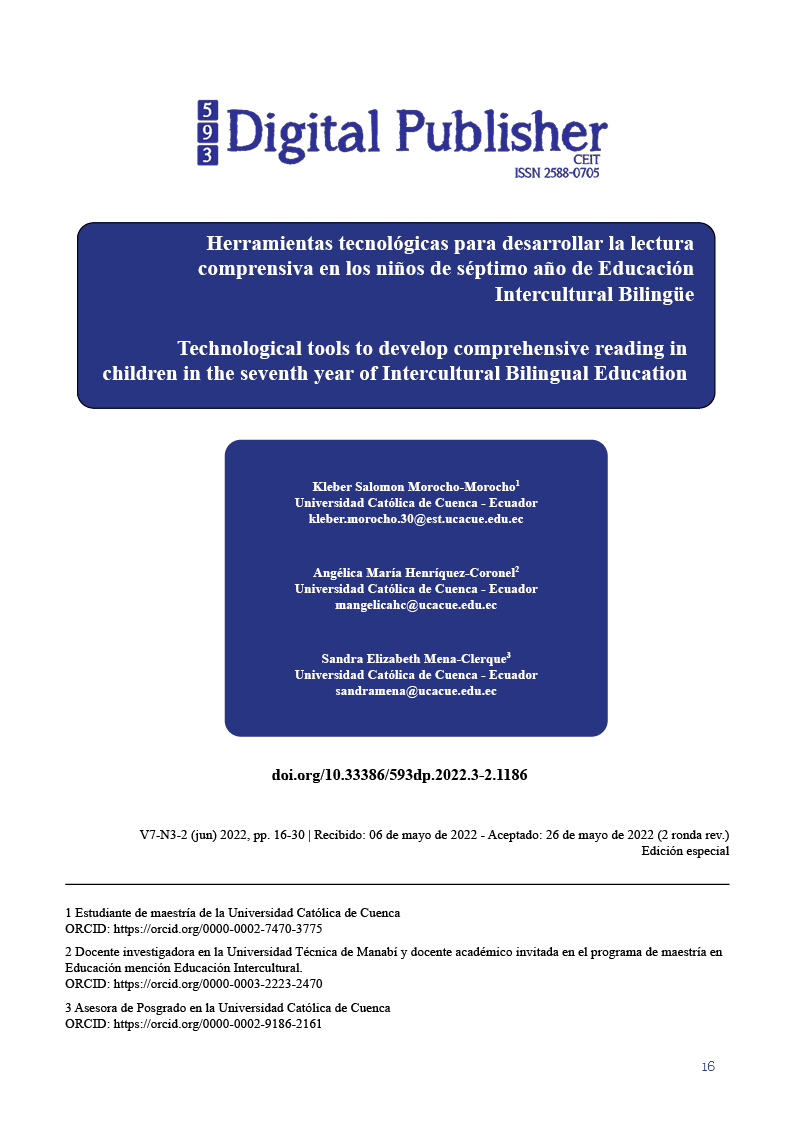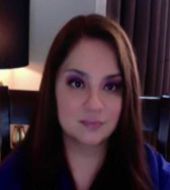Technological tools to develop comprehensive reading in children in the seventh year of Intercultural Bilingual Education
Main Article Content
Abstract
This article aims to apply the different technological tools through various applications to improve and develop comprehensive reading in children in the seventh year of Intercultural Bilingual Education. This research was carried out in an experimental, mixed type that used the observation sheet for students to determine the importance of applying the Liveworksheets platform in the development of comprehensive reading in order to motivate and practice the reading habitat in the educational institution. both in the family. In this way, it is identified the students are interested in developing reading using this platform. Therefore, these resources are essential for teachers as well as students because they allow to dynamize the learning process, facilitating the work for teachers as well as for students because it helps to avoid using many printed texts since they are applied in digital files. For which teachers must propose new methodological strategies in the use of different technological resources and be predisposed in the application.
Downloads
Article Details

This work is licensed under a Creative Commons Attribution-NonCommercial-ShareAlike 4.0 International License.
1. Derechos de autor
Las obras que se publican en 593 Digital Publisher CEIT están sujetas a los siguientes términos:
1.1. 593 Digital Publisher CEIT, conserva los derechos patrimoniales (copyright) de las obras publicadas, favorece y permite la reutilización de las mismas bajo la licencia Licencia Creative Commons 4.0 de Reconocimiento-NoComercial-CompartirIgual 4.0, por lo cual se pueden copiar, usar, difundir, transmitir y exponer públicamente, siempre que:
1.1.a. Se cite la autoría y fuente original de su publicación (revista, editorial, URL).
1.1.b. No se usen para fines comerciales u onerosos.
1.1.c. Se mencione la existencia y especificaciones de esta licencia de uso.
References
Acuerdo Nro. MINEDUC-MINEDUC-2020-00038-A, M. de E. (2020). Asamblea Constituyente. 811, 7. https://n9.cl/z5y9
Anilema-Guamán, J., Moreta-Herrera, R., & Mayorga-Lascano, M. (2020). Diagnóstico De La Comprensión Lectora En Estudiantes Del Cantón Colta, [Ecuador Diagnosis of Reading Comprehension in Students of Colta Canton, Ecuador ]. Universidad Ciencia y Tecnología, 24(100 SE-Educación), 56–65. https://n9.cl/7jrol
Castillero-Mimenza, O. (2021). Los 20 tipos de lectura más importantes. Diferentes maneras de leer patrones de signos gráficos, ya sean textos con letras o no. [The 20 most important types of reading. Different ways of reading graphic sign patterns, whether they are texts with letters . Psicologia y Mente, 1–13. https://n9.cl/bhae
Cevallos-Salazar, J. E., Lucas-Chabla, X., Paredes-Santos, J., & Tomalá-Bazán, J. L. (2019). Beneficios del uso de herramientas tecnológicas en el aula para generar motivación en los estudiantes [Benefits of using technological tools in the classroom to generate motivation in students]. Revista Ciencias Pedagógicas E Innovación, 7(2), 86–93. https://doi.org/10.26423/rcpi.v7i2.304
Figueroa, V., Burgos, F., & Guerrero, M. (2017). Actitud De Los Docentes Hacia El Uso De La Computadora En Las Escuelas De República Dominicana Attitude of Teachers Toward Using the Computer in Schools in Dominican Republic [Attitude of Teachers Toward Using the Computer in Schools in the Dominican Repu. 51, 1133–8482. https://n9.cl/hk2f0
Flotts, P., Manzi, J., Polloni, M. del P., Carrasco, M., Zambra, C., & Abarzúa, A. (2016). Aportes para la enseñanza de la lectura [Contributions for teaching reading]. Organización de Las Naciones Unidas Para La Educación, La Ciencia y La Cultura. https://n9.cl/r23it
Franco-Bayas, Mi. A., & García-León, E.-L. (2019). Influencia del uso de una plataforma gratuita en el aprendizaje del inglés en Babahoyo Influence of the use of a free platform in learning English in Babahoyo Influência do uso de uma plataforma gratuita no aprendizado de inglês em Babahoyo Miguel [Influe. Dominio de Las Ciencias, 5(2), 209–222. https://n9.cl/yhmzz
Gómez-Valdez, M. del R. (2019). Beneficios del uso de las nuevas tecnologías de la información como herramienta en la docencia [Benefits of using new information technologies as a teaching too]. Revista Iberoamericana de Producción Académica y Gestión Educativa, 6(12), 15. https://n9.cl/53yax
Gómez, T. (2019). La Importancia de la lectura a nivel superior [The Importance of Higher Level Reading]. Perspectivas Docentes. https://n9.cl/gluod
González-Gómez, L. (2019). La comprensión lectora y su importancia para estudiantes de la Universidad Mundo Maya, campus Campeche [Reading comprehension and its importance for students of the Mundo Maya University, Campeche campus]. Revista Electrónica Gestión de Las Personas y Tecnología, 12(36), 33–41. https://n9.cl/xp18e
Jiménez, A. M. (2017). Sobre lectura, hábito lector y sistema educativo [On reading, reading habit and educational system]. Perfiles Educativos, 39(155), 3–18. https://doi.org/10.22201/iisue.24486167e.2017.155.58100
Lengua-Cantero, C. C., & Lambraño-Pérez, L. M. (2016). Usos y realidades de las tecnologías de la información y la comunicación en las instituciones educativas del sector oficial del Municipio de Sincelejo [Uses and realities of information and communication technologies in educational institutions of the off. Desbordes. Revista de Investigaciones. Escuela de Ciencias Sociales, Artes y Humanidades - UNAD, 4, 103. https://doi.org/10.22490/25394150.1292
Ministerio de Educación, E. (2017). Ley Orgánica de Educación Intercultural (LOEI). Registro Oficial No. 417 de 31 de Marzo de 2011, 417, 16. https://bit.ly/3hB7t8h
Reyes-Chavez, R., & Prado-Rodríguez, A. B. (2020). Las Tecnologías de Información y Comunicación como herramienta para una educación primaria inclusiva [ Information and Communication Technologies as a tool for inclusive primary education]. Revista Educación, 44, 32. https://doi.org/10.15517/revedu.v44i2.38781
UNESCO. (2017). Más de la mitad de los niños y adolecentes en el mundo no ésta aprendiendo [More than half of the children and adolescents in the world are not learning]. Uis Instituto De Estadística De La Unesco, 0(46), 18–26. https://n9.cl/o9wr




